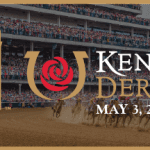What we know (and don’t) about Maryland racing’s future
Whither Laurel and Pimlico? Whither, for that matter, Maryland racing writ large? Those are the questions on many minds, both inside Maryland and out, as the clock ticks and – three and nearing four years after the Racing and Community Development Act was supposed to put those questions to rest – not one thing has occurred at either facility that suggests a reprieve is at hand.
Maryland’s legislature was sufficiently concerned about the projects’ progress – more precisely, the lack thereof – that in its 2023 session it created a Racetrack Operating Authority tasked with untangling the Gordian knot. The Authority must report back to the General Assembly by December 1 – there’s that clock a-ticking once again – on a variety of topics, among them “a review of best practices for thoroughbred industry operating models” and a recommendation for how Maryland’s racing industry should operate going forward.
At this point – the Authority has had three official meetings, with a fourth slated for September 29 – the unknowns outnumber the knowns. But here are a few things we do know.
Financially speaking, the project hasn’t drowned, but it is “very underwater.”
“Very underwater” is the phrase Operating Authority chairman Greg Cross used to describe the financial state of things during the Authority’s August 23 meeting, and he’s not wrong.
In its presentation to the Operating Authority that day, the Maryland Stadium Authority priced six different approaches to rebuilding the tracks. The most cost-effective of the bunch was, at the end of 2022, estimated to cost $527 million. That’s $119 million more than the estimated available funds.
And the least cost-effective? That one came in at more than $350 million over budget.
And that means…
That means that Maryland is headed into a (primarily) one-track future. The new industry understanding is that operating two full-fledged racetracks in the same market with only one revenue stream is not feasible in the modern era. Once home to Laurel, Pimlico, Bowie, Havre de Grace, and a thriving group of “half-milers,” Maryland soon will be down to one primary track and the one remaining half-miler, Timonium.
Which track will it be?
“Likely Pimlico,” Cross said at the August 23 meeting. That’s for political reasons; the political powers-that-be in Annapolis want to keep the Preakness in Baltimore and thus, at Pimlico.
Moreover, part of what sold the project to the General Assembly was the promise of turning Pimlico into an economic and community asset for Park Heights.
Is Pimlico large enough to house Maryland’s racing industry in its entirety?
No. Hence, the need for a training center someplace else. The legislation that created the Operating Authority directs the group to explore the feasibility of “at least two alternative thoroughbred training facilities.”
It’s been a bit of a rocky start for the Authority.
The Racetrack Operating Authority was created in the most recent legislative session, had members appointed in June, and is tasked with developing a report that could become the blueprint for the industry’s future by the beginning of December.
Amid that sort of whirlwind, it was inevitable that there would be some miscues, and there have been: for example, technical glitches that plagued the online connection to one meeting and left online participants unable to see a presentation made. In addition, the Authority doesn’t yet have a working website, so the public’s ability to know what is going on has been hampered.
Perhaps more frustrating is that two of the three public meetings it has held were very, very brief, with the Authority almost immediately moving into closed session. While closed sessions are permissible under state law, the short public meeting-closed session combo leaves an unsettling impression.
CHECK OUT THE LATEST OFF TO THE RACES RADIO!
Indeed, the Maryland Horse Council on Sept. 8 sent Cross a letter expressing its concern “that the Thoroughbred Racetrack Operating Authority (TROA) is not complying with the Maryland Open Meetings Act, and we are concerned that the Thoroughbred racing sector will be unfairly penalized by the public as a result.”
Specifically, the letter, from MHC president Kim K. Egan, charges that the Authority has not complied with public notice requirements or with the regulations governing closed sessions.
In response, Cross wrote, “As the Authority continues to solidify its processes, the Authority welcomes the opportunity to speak with you to discuss engaging the industry and public.”
Why have things gone sideways?
You have your picks of numerous reasons, or buy our FunPack and take all of them! Sigh.
At the conclusion of the 2020 legislative session – at which the Racing and Community Development Act passed and became law – the pandemic hit. That was not good news for the project, which saw costs driven up by inflation and supply chain issues, while rising interest rates also reduced the buying power of the bonds to be issued.
That’s not all, though.
Laurel Park turned out to be in far worse condition than originally thought. The Maryland Economic Development Corporation (MEDCO) recommended that, outside the paddock, which has historical and architectural merit, “[I]t is the assessment of MEDCO real estate/development staff that the structures at Laurel do not warrant additional investment, and demolition is the logical next step.”
The problems are also because of changes to the original plans that drove up costs, Stadium Authority Executive Vice President Gary McGuigan told the August 23 meeting.
At Pimlico for example:
“One of the biggest [changes] was the clubhouse,” McGuigan said. “It was originally anticipated to be 60- to 70,000 square feet. And by the end of that year after we started looking at it, it basically doubled from the desires of the Stronach Group.”
Additionally, while the original plan called for essentially a modular Pimlico, built out for the Preakness festival, “There was a desire by the Stronach Group to have more permanent structures,” he said.
And then there was the racetrack, originally slated to be rotated and shortened to 15/16 miles to free up more developable parcels. “There was a drive by the Stronach Group and the horsemen to keep a one-mile track,” he told the Authority. “It doesn’t seem that would mean a great deal. But when you rotate and expand the track to a mile, it would mean that there would be additional land that would need to be purchased or swapped with LifeBridge.”
The current plan envisions rotating the track “to capitalize on the development parcel creation” while maintaining it at the one-mile distance.
So: grander plans, a constrained funding source, and spiraling costs. The perfect storm.
What about the elephant in the room?
An important charge to the Racetrack Operating Authority was the General Assembly’s directive that it conduct “a review of best practices for thoroughbred industry operating models” and recommend how Maryland organize its industry going forward.
That could mean any number of things, from the current model (private racetrack operator) to something more like NYRA. What it will recommend, whether those recommendations will be enacted, and if so, how: those are thorny and at current unresolved questions.
What next?
The next Racetrack Operating Authority meeting is September 29. The major agenda item: “Discussion and Presentation by Maryland Jockey Club of their Views Concerning Maryland Racing.”
The Authority’s first big deliverable – its report to the General Assembly – is due December 1.
And after that, well, things could get very interesting, indeed.
LATEST NEWS
















Frank, fantastic article, what I’ve always wondered is who decides how many racing dates a track or state has? I seems the boutique model like Colonial, Delaware, Monmouth etc. is much more effective for the track owners. Why do they race 150 dates a year without the benefit of a casino like the WV tracks? Also, whatever happened to the MD tracks getting sports betting? The most recent licenses went to restaurants like the Greene Turtle in Canton.
Racing is a welfare recipient anyway. It’s not sufficient and relies on slot money to survive. Using how many jobs they provide and saving green space to tug on the heartstrings of people. That slot revenue could surely be used elsewhere rather than help a very small percentage of the state. The track should conduct a short Kentucky downs like Preakness meet since that weekend is the only time the track doesn’t lose money.